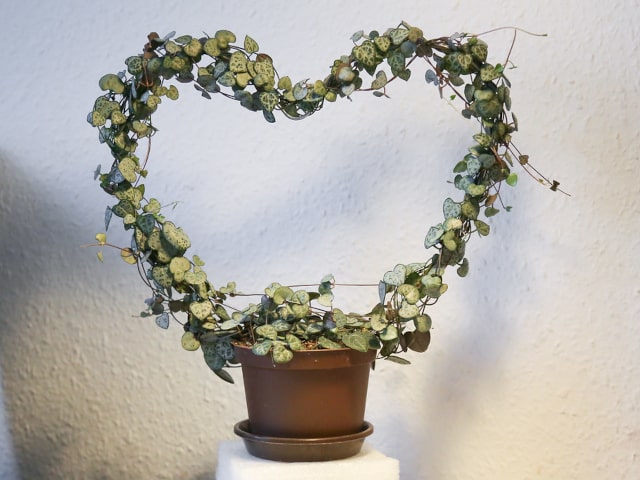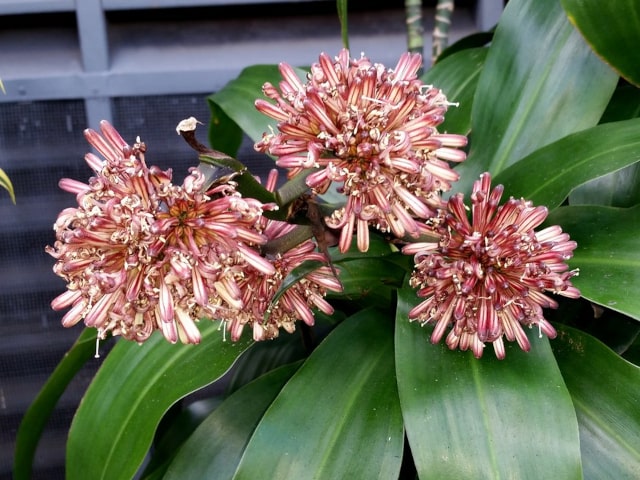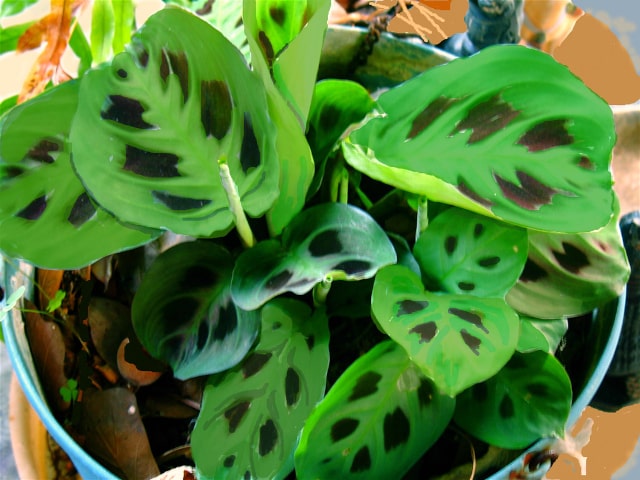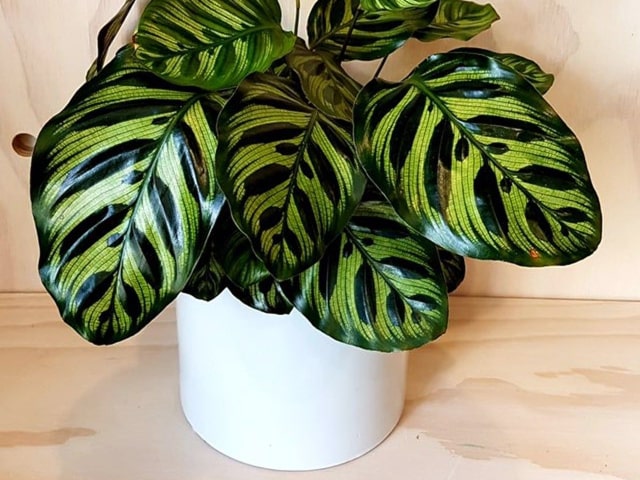
The String of Hearts (Ceropegia woodii) is a gorgeous, low-maintenance plant you can keep in your home. It has beautiful hearth-shaped leaves that go down thing vines. The flowers are pink in color and eye-catching.
This striking plant is native to South Africa and Zimbabwe and it is known under many different names, including the String of Hearts, Chain of Hearts, Rosary Vine, Sweethearts Vine and Hearts Enmeshed. The last name comes from the fact that the vines can get easily tangled.
A great thing about the String of Hearts plant is that it is easy to grow. It requires low effort, so it is good for beginner gardeners. It should get bright but indirect light. It needs to be watered only when the soil is dry and it has to be fertilized every two weeks during the growing season. These simple things will keep this beautiful tropical plant happy and thriving.
Plant Facts
The String of Hearts is famous for its vines that trail easily. The leaves are eye-catching: hearth-shaped, variegated green and silver. Typically, the foliage is deep green with a bit of silvery white. This gorgeous foliage is one of the main reasons people choose to grow the String of Hearts in their homes. The underside of the leaves is pinkish, with purple or pink stems.
The plant flowers in small, bulbous flowers. These flowers are shaped as Chinese lanterns and are of magenta color. The flowers often blend in with the leaves. Keep in mind that the String of Hearts blooms only when it grows in favorable conditions. The flowers have a bulbous shape at the base, and it grows into a long cylinder. The flower is topped with a tent of petals. Typically, the String of Hearts will flower in the middle of summer and into the fall. However, flowers can appear at any time.
When grown as a houseplant, the String of Hearts will develop 2 to 3 feet in length. The vines are wiry, and you might notice small, bead-shaped bulbs along the vines. These bulbs are small tubers and they grow sporadically on the vines. You can plant these tubers to grow new plants.
While the String of Hearts is not a true succulent, keep in mind that it can store plenty of water in its leaves. The plant prefers heat and dry soil, so this is something to keep in mind when growing this plant in your home.
Keep in mind that the String of Hearts is just one variety of Ceropegia plant. Turtles is another popular variant. Other related plants include Bushman's pipevine, Necklace Flower and Wine-Glass Vine. All of these plants are also related to the milkweed species.
If you wish to make your String of Hearts thrive, here are the main care requirements that you need to provide:
Light
The String of Hearts originates in Africa, so it prefers some bright sun during the day. However, it will also do well in indirect light, as long as it is bright. The main difference is the foliage hue. If you grow your plant in direct light, the foliage will be dark green, with variegated silver markings. When grown in indirect light, the foliage will be lighter green and it will have softer markings.
Keep in mind that this plant can survive in a low light environment, but it will affect the color of the foliage. In low light, the leaves end up being pale green, with no variegation. Keep in mind that the loss of variegation is likely permanent. It will not return even if you move your plant to a brighter spot in your home.
Soil
The String of Hearts can store a lot of water in its leaves, so it's known as a semi-succulent. It also means that the soil you choose needs to be appropriate. This plant never enjoys having "wet feet". It doesn't like to sit in wet soil, so it's an imperative to choose potting mix that is well-draining. It is also important to make sure that the soil you choose can get dry completely between waterings.
One of the best choices for this plant is a pre-mixed cactus soil. However, you may also choose any well-draining potting mix that has a generous amount of sand or perlite. You may also use a more complex mix of equal parts succulent and cactus mix, coco coir and a combination of charcoal and orchid bark. You can also add some compost and worm castings to this mix. This is a complex potting mix that will make your String of Hearts thrive.
However, if you don't want to invest money and effort to make this mix, it is fine. Your plant will thrive in any well-draining soil. For the best results, make sure to add some sand and perlite to any potting mix you choose to use. This will ensure quick drainage.
Temperature
Keep in mind that the String of Hearts is a tropical plant that is native to Africa. It means that enjoys hot temperature and it can't do well in cold environments. To make your String of Hearts thrive, make sure to keep your plant in temperatures above 60 degrees F (15-16 degrees Celsius). However, it is best if temperatures are between 70 and 85 degrees F (21-29 degrees Celsius).
If you live in a hot climate, you may choose to grow your String of Hearts outdoors. If you live in more temperate areas, you can take your plant outdoors during the summer.
However, it is important to acclimate your String of Hearts before you move it outside. Make sure to acclimate your plant so it doesn't get into shock or gets sunburns. To acclimate your String of Hearts, start by moving it outside for one hour per day. Gradually increase the time your plant spends outside over the course of several days. This will help your plant adjust to outdoors environment. You should always bring your plant back inside if a cooler weather develops. If you do this, remember that you need to acclimate your plant to the indoors in a similar way.
Humidity
The String of Heart is a semi-succulent, which means it doesn't need a lot of humidity. Your room's humidity is likely to be fine, so chances are that your home's condition are good for this plant. However, if your environment is humid, you will probably need to water your plant less often.
Like many succulents, the String of Hearts does not require a lot of humidity to thrive. Your average, indoor humidity should be just fine because this plant prefers low humidity. You may not need to water the plant as often in a very humid environment.
Watering
The String of Hearts can keep water in its leaves, so you should never over-water it. In fact, this is the worst thing you can do. Over-watering can cause more harm to this plant than underwatering. The String of Hearts is a drought-tolerant plant. Keep in mind that it is a semi-succulent, so it can thrive without much water. Make sure to water it only once the soil has completely dried out. Wait until it is dry again before water it next time.
This watering regime should be even lower during the winter months. The best way to go is to allow your String of Hearts to rest. Water a little bit less. Your plant might look a bit droopy during the winter, but don't add more water to try to compensate. Your String of Hearts will enter a semi-dormant state which prepares it for new growth in the spring. You shouldn't do anything to disturb this state.
Fertilizer
You should use fertilizer to help your String of Hearts grow longer vines. It will also help keeping your plant happy and pest-resistant. To know how much fertilizer to apply, you need to understand String of Heart's growing season. The growing seasons lasts from spring until the middle of the summer. The other season is the semi-dormant season, which lasts from the fall through the winter. You should only fertilize your plant during the growing season.
The best way to feed your plant is to use a liquid or water-soluble fertilizer. The fertilizer needs to be balanced. Some people prefer to use a diluted fertilizer at every watering. This is a good option if you keep forgetting when to fertilize your plant.
Make sure to stop fertilizing your String of Hearts in the middle of the summer. Your plant needs some time to slow down to prepare for its semi-dormant stage in the fall and winter. This is why you should stop fertilizing a few weeks before the fall.
Pruning
Keep in mind that the String of Hearts tends to be wispy. If you grow it indoors, the vines will only grow about two feet in height. However, in its natural environment, the String of Hearts can grow up to 12 feet long.
Generally speaking, pruning is not necessary for this plant. However, you should monitor your String of Hearts. If the vines become too long for your taste, or if they look too leggy, you can prune your plant freely. You can also prune your plant if you wish to propagate it using cuttings.
To prune String of Hearts, simply use a pair of scissors or shears to snip off the vines. Cut wherever you want a vine to end. The plant is hardy enough to withstand even harsh pruning, so you don't have to worry about being precise. You can use clippings to propagate your plant (see below). You can propagate by starting clippings in the soil or by placing them in the water.
Propagating
As noted above, propagating your String of Hearts can be done easily. Propagation is almost always successful. There are two main methods of propagation: using tubers and using clippings. Tubers are small and look like beads or peas. They grow along the vine.
You can propagate your plant by simply planting these tubers into the soil. The best approach is to propagate while tubers are still attached to the mother plant. Set your plant into a shallow tray of succulent soil mix. Arrange the vines so the tubers lay on the soil in the tray. Mist the soil gently so it s damp but not wet. Observe your plant: once the tubers take root and starts to develop new leaves, you can cut them from the mother plant. Simply cut the vine in between to separate new plants from the mature plant.
Once they are ready, repot new plants into their own pot. Alternatively, you may stick the tubers into the soil of the pot the plant is already in. Or you may cut off the tubers and replatnt them separately. However, you are likely to have better results if you allow tubers to stay attached to the mother plant for a while after being planted.
Another way to propagate is with cuttings. This is an easy method: simply cut several vines and place the cut ends into their own pot of soil. Dampen the soil but make sure that it isn't too wet. Damping the soil will encourage rooting. Alternatively, you can place the ends of cut vines into water. They will grow roots in time so you can repot them into their own container. Just make sure to use a succulent mix or another well-draining soil.
Planting and Repotting
If you need to plant the String of Hearts, the best way to go is with a relatively small pot that has a few drainage holes. Never overpot. Also, don't use a container that is too big for the plant. The String of Hearts prefers to have its roots slightly restricted. The best pots to use are porous containers, such as terracotta. These will help drying out the soil more quickly. Plastic pots tend to retain moisture, which is not good for this plant. For the soil, make sure to use a well-draining potting mix. Succulent soil mix is a good choice. You can also mix potting soil and sand.
To plant, fill the container with the potting mix to about half. Gently set roots of the plant into the soil. Carefully, cover the roots and press the plant in lightly. Keep in mind that any tubers that rest on the soil will eventually turn into new plants. Arrange its vines to trail down the side. Once this is done, give a plant a deep watering, but make sure not to water again until the soil has completely dried out.
When it comes to repotting, keep in mind that the String of Hearts prefers to have its roots slightly constricted. It means that you will not need to repot your plant often. It might happen that you won't ever need to do repotting. However, if you need to repot, keep in mind that the best time to do so is in the spring. Observe your plant and repot it when the new growth begins to show. Ideally, you should repot a bit before this happens.
To repot, use a container with drainage holes. This will prevent water buildup and will promote good drainage. It will help the soil dry out completely. Prepare your chosen soil mix. Dampen the soil before you put it into the pot.
Gently slide your String of Hearts out of its current pot. This is best done if you lay your plant on its side. In case you grow multiple plants in one pot, this is a good moment to split them into different containers. Once the plants are ready, gently place them root first into the new container. Place the roots into the container and lightly press the soil around the roots. Make sure that the soil dries out completely before you water.
Diseases and Pests
The String of Hearts is known as a hardy plant. There are only a few issues you need to worry about. The most common problem for this plant is overwatering. This can cause root rot and it can damage or even kill the plant. You can avoid this problem by not over-watering: you should always allow the soil to dry out completely before you water again.
The second problem is a pest: mealybug. These are small bugs that hide in a white webbing and feed on the plants. This can weaken or even kill the plant. To get rid of these pests, wash them off with water.
How to Display Your String of Hearts
For the most striking effect, you should plant your String of Hearts in a hanging pot or basket. You can hang it in a window: this will ensure eye-catching display and it will give your plant plenty of light.
Alternatively, you can place the container on a plant stand. This will allow the vines to trail down on all sides, creating a striking visual effect with its foliage. You can also place it on the shelf or any other sunny spot where your String of Hearts can get the attention it deserves.
During the summer, you can hang your plant's basket in a shade of a tree outside. It will give your plant some bright light without causing sunburn. It will look gorgeous outside, along with other plants and trees in your garden.
Photo credit: Maja Dumat




0 Comments